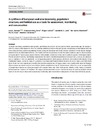Identificador persistente para citar o vincular este elemento:
https://accedacris.ulpgc.es/jspui/handle/10553/30035
| Título: | A synthesis of European seahorse taxonomy, population structure, and habitat use as a basis for assessment, monitoring and conservation | Autores/as: | Woodall, L.C. Otero-Ferrer, Francisco Correia, M. Koldewey, H.J Curtis, J.M.R. Garrick-Maidment, N. Shaw, P.W. |
Clasificación UNESCO: | 251001 Oceanografía biológica 251092 Acuicultura marina 3105 Peces y fauna silvestre 310502 Piscicultura |
Palabras clave: | Conservation management Environmental assessment Environmental management environmental monitoring Finfish, et al. |
Fecha de publicación: | 2018 | Publicación seriada: | Marine Biology | Resumen: | Accurate taxonomy, population demography, and habitat descriptors inform species threat assessments and the design of effective conservation measures. Here we combine published studies with new genetic, morphological and habitat data that were collected from seahorse populations located along the European and North African coastlines to help inform management decisions for European seahorses. This study confirms the presence of only two native seahorse species (Hippocampus guttulatus and H. hippocampus) across Europe, with sporadic occurrence of non-native seahorse species in European waters. For the two native species, our findings demonstrate that highly variable morphological characteristics, such as size and presence or number of cirri, are unreliable for distinguishing species. Both species exhibit sex dimorphism with females being significantly larger. Across its range, H. guttulatus were larger and found at higher densities in cooler waters, and individuals in the Black Sea were significantly smaller than in other populations. H. hippocampus were significantly larger in Senegal. Hippocampus guttulatus tends to have higher density populations than H. hippocampus when they occur sympatrically. Although these species are often associated with seagrass beds, data show both species inhabit a wide variety of shallow habitats and use a mixture of holdfasts. We suggest an international mosaic of protected areas focused on multiple habitat types as the first step to successful assessment, monitoring and conservation management of these Data Deficient species. | URI: | https://accedacris.ulpgc.es/handle/10553/30035 | ISSN: | 0025-3162 | DOI: | 10.1007/s00227-017-3274-y | Fuente: | Marine Biology [ISSN 0025-3162],v. 165 (1), (Enero 2018) | URL: | http://api.elsevier.com/content/abstract/scopus_id/85037360126 |
| Colección: | Artículos |
Citas SCOPUSTM
37
actualizado el 08-jun-2025
Citas de WEB OF SCIENCETM
Citations
36
actualizado el 08-jun-2025
Visitas
82
actualizado el 08-jun-2024
Descargas
42
actualizado el 08-jun-2024
Google ScholarTM
Verifica
Altmetric
Comparte
Exporta metadatos
Los elementos en ULPGC accedaCRIS están protegidos por derechos de autor con todos los derechos reservados, a menos que se indique lo contrario.
